Declaration of Dependence
by Laura McLean-Ferris
Here we have a generation of artists working with dependency, sociality, contagion, implication and guilt — issues that are both structurally germane to the art world and also increasingly relevant to the world beyond it.

Anne Imhof. DEAL. 2015. Performance: MoMA PS1, New York. Photo: Nadine Fraczkowski. Courtesy MoMA PS1.
This essay on the art of Anne Imhof — and a generation of fellow artists exploring dependency, public behavior, and social guilt — appeared in issue no. 1 of Even, published in May 2015. In May 2017, Anne Imhof won the Golden Lion at the 57th Venice Biennale.
I.
“I worked really hard to get here,” says a young woman on the floor. She is kneeling at the side of a large trough full of buttermilk. Her eyes are glassy and carry some weak flicker of indignant rage, but her face remains expressionless. She speaks her words as though she is carrying out banal orders. There’s a white, sticky, milky substance all around her mouth — it’s the buttermilk, but certainly suggests quite another fluid. It falls from her chin in long, viscous drips, and she does nothing to wipe it away; there are partially dried white stains all down the front of her shirt. Ostensibly, she’s a zombie — oblivious to what she’s been doing, her mouth stained with a substitute for blood — but here, she’s making too much sense. “No one else cares,” she continues flatly, “but that’s why I love you. Because you say ‘I’ for me.” A soundtrack roars ominously like a howling wind. There are other actors, too: men and women seen in a bluish light that turns every color to a flat monochrome. Each makes similarly dead-eyed but coherent declarations.
This unremittingly bleak sequence was part of German artist Anne Imhof’s performance DEAL, which took place over a number of days at MoMA PS1 in New York in January 2015. It was the latest in a series of works by the artist that have sought to make power dynamics concrete, visible, and part of the sensory realm, creating choreographed literalizations of social worlds. It’s also indicative of a larger trend that is slowly beginning to make itself felt: artists consciously making visible the powerful effects of the seemingly ever-strengthening ties that bind us together in a networked society. These artists are not taking on the task of picturing something too large to see (perhaps it’s worth recalling Stéphane Mallarmé’s direction to “paint not the thing, but the effect that it produces”). Instead, the feeling of the network is what’s crucial here. So, then, to the effects: here we have a generation of artists working with dependency, sociality, contagion, implication and guilt — issues that are both structurally germane to the art world and also increasingly relevant to the world beyond it.
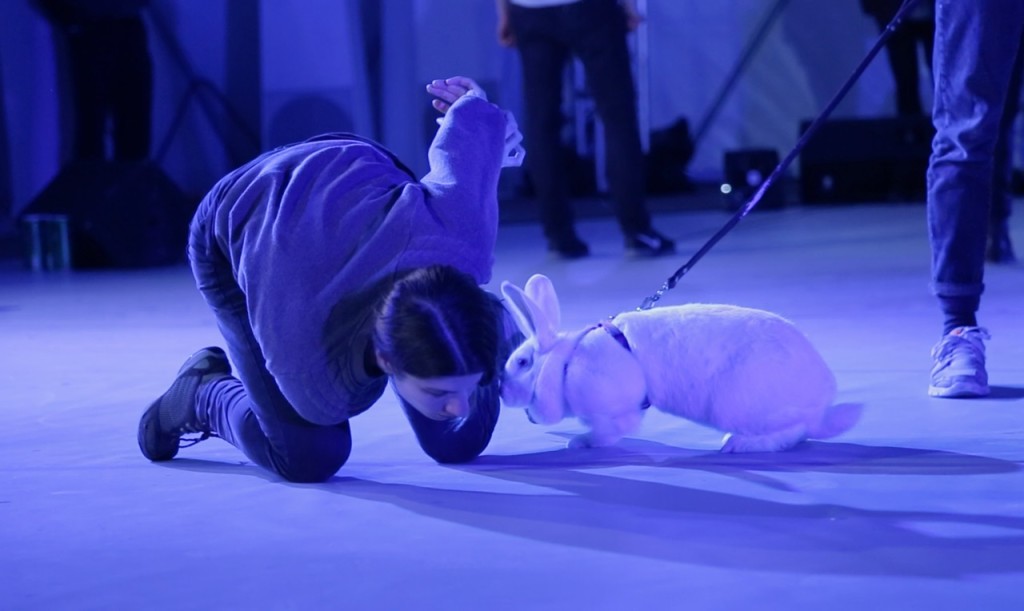
Objects and figures that are passively eating and being eaten have recurred in works by artists who are constructing complex systems in which actors are caught up in a mutual exchange of consumption. French artist David Douard’s exhibition “Mo’Swallow,” at the Palais de Tokyo in 2014, featured assemblage fountains, cobbled together with patio junk, large plastic petals and pipes, in which water gurgled and dribbled. A video animation showed disembodied heads in kitchen sinks, open-mouthed below a tap, from which white liquid poured down their gullets, almost drowning them. Scrolling text described a sick society addicted to poisoned breast milk, using a language that seemed part teenage patois, part text-speak.
Russian-born, New York-based artist Alisa Baremboym has been producing a body of sculptures in which one material absorbs another. Unglazed, porous ceramic sculptures, pinkish folds and slabs that resemble flanks of flesh or sausage meat, occasionally inlaid with outlets or USB ports, are laid on emollient gels. The thirsty ceramics drink up the liquid from the gel slowly, over a number of months or years, growing increasingly wet and stained. Recently she has integrated these elements into larger installations of mangled belts of black steel, resembling a ruined factory production line. The installation is partially supported by bungees and ropes hanging from the ceiling or walls, conveying a further sense of parasitic dependency, in this case on the architecture itself.
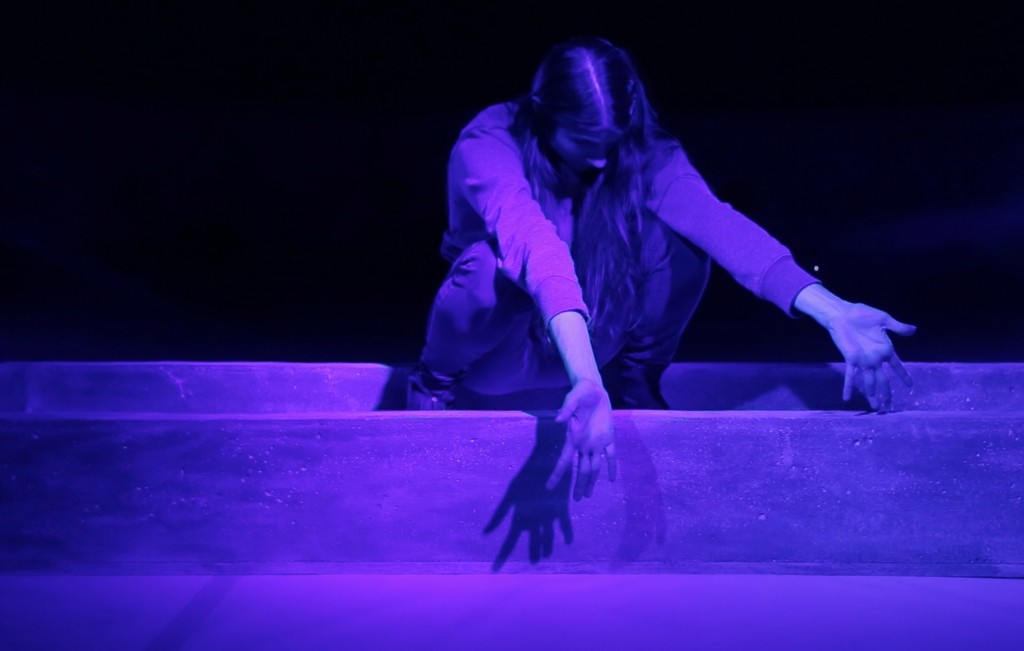
Exploring a more digital breed of dependency, Ian Cheng, also based in New York, has been creating a series of real-time simulations featuring nascent forms of algorithmic, artificial intelligence and decontextualized elements from video games: plants, animals, landscapes and so on. These elements are programmed to reshape themselves as though a kind of digital primordial soup or swamp, consistently shifting in appearance. His latest virtual reality simulations, shown on multiple freestanding screens at Kunsthalle Düsseldorf, were networked together so that they had the ability to influence one another. If one simulation felt it wasn’t getting enough attention, it could “eat away” elements of one of the others. It’s a zero-sum game of influence and attention in a network of totally symbiotic energy consumption.
The past decade has seen many artists grappling with the conditions of the internet in a way that is essentially medium-specific. That is to say, they explore the precise conditions of digitization and online networks as though they were investigating the formal qualities of a material such as paint, photography or video. If we consider the systems by which images are distributed online, for example, to be kinds of tools akin to a brush or a pencil, then we have seen artists dramatize their virtuosity with said tools by creating physical artworks that are then defined by their distribution — designing the art world to mirror the digital. The troublesome term “post-internet,” still subject to some debate, has been used as a catchall to describe such work. For an example, take Artie Vierkant’s Image Objects (2011–): cheerfully colorful geometric shapes, such as layered squares, begin life as digital files. They are printed on Dibond (an aluminum composite) and then cut into shapes that give them the fragmentary appearance of a scrap of a Photoshop image. Hung in a gallery, the works are photographed as an installation, and each of those installation shots is then altered further, creating a new image to be printed for the next show — and so on and so forth, ad infinitum. Accompanying this kind of work has been a focus on the particular aesthetics of the online world as it is experienced through screens: iPhone messages, high-definition CGI, colorful gradients, and so on.

The political ramifications of screen technologies are enormous, and yet, particularly since the revelations of Edward Snowden, it has become clear that some of the most significant power is wielded invisibly, in ways that are hard to represent via images. Last year, when asked how the art world would respond to the effects of “big data,” artist Trevor Paglen wrote: “I have a feeling that those of us who are interested in visual literacy will need to spend some time learning and thinking about how machines see images through unhuman eyes, and train ourselves to see like them.”
II.
During the height of summer 2014, all of a sudden, individuals the world over began making videos of themselves dumping buckets of freezing water and ice cubes over their heads. When they were finished shrieking, often shivering and dripping in water, but usually smiling, they would say the names of three other people, thereby impelling them to carry out the same task in what was called the Ice Bucket Challenge. They would then post the video online, and tag their three targets. That this liquid dumping took place in the name of raising money for a charity (to support ALS research) was less important to its success than the fact that the request had been publicly made. For social reasons, it was easier to throw a bucket of water over one’s head than it was to decline the challenge, or ignore it.
I didn’t enjoy seeing this happen. Yet increasingly it returns to me when I think about the perils of our newly “public” life. The Ice Bucket Challenge was a visceral episode of mass coercion, in which your social network was making itself physically felt by dumping freezing water on you. The videos themselves aside, this viral phenomenon didn’t necessarily privilege sight, but rather interconnectivity and the shock of physical sensation. Perhaps most importantly, as a direct instruction from a meme to carry out an unpleasant task, it went largely obeyed.

Okay, I’m aware that I am describing a lighthearted fundraising drive with a slightly portentous tone, and that in fact it had the usual qualities of a summer craze — Eurodance routines, cronuts, “Gangnam Style,” that kind of thing. But there remains to me something important about that visceral image of a dripping-wet friendship that has been reflected in works such as Imhof’s DEAL. Because, looking at it now, it’s almost a relief to see the impact of social networks and power dynamics physically realized in actual human goose-bumped skin. So often, the metaphorical language used to discuss social networks runs to fluffy clouds, immateriality, and a vague concept of sharing. Here, at least, was something that took a tangibly different form. The realities of public relations, performance, mass persuasion, and power dynamics were literally enacted on human bodies (albeit in the name of a good cause). Celebrities were doing it, similarly name-checking one another, which only served to increase an atmosphere of public thrill and connection. Everyone “wet” was connected by degrees, all part of the same dripping network of diffused fame. Not only one of the most high-profile instances of any number of memes or trends, the Ice Bucket Challenge most clearly demonstrated a performative contagion. And the flipside of this cheery goodwill is seen in Imhof’s DEAL, where individuals seem compelled to obey directions which remain outside their control.

Throughout DEAL — in both its realization as a performance, and as a later video work that juxtaposes footage from the performance with shots from the seashore and rooftops, there are moments that the white, sticky, slightly translucent buttermilk stands in for a kind of ejaculate. “I worked really hard to get here” is, no doubt, one of the most depressing lines spoken in DEAL, and even more so in this reading. Spoken by broken individuals, these are the words of the debased; spoken by a pornographic subject, these become words from which virtually all sexuality has been extracted. At certain moments the performers open their mouths into an O shape and gently beat their own cheeks to create a wet slapping sound, as though they were performing oral sex on some invisible entity. Yet the creamy liquid stands in for all sorts of stickiness. Performers cupped the buttermilk in their hands and drizzled it over one another’s linked wrists and elbows, as though sealing a social contract in the manner of “blood brothers.” They also took mouthfuls of the liquid and squirted it though their teeth, or slowly dribbled territorial patterns on the floor. Occasionally gobfuls of buttermilk would simply fall horrendously from their mouths and slop down the front of their clothes, leaving them covered in liquid that would eventually dry to a chalky stain.
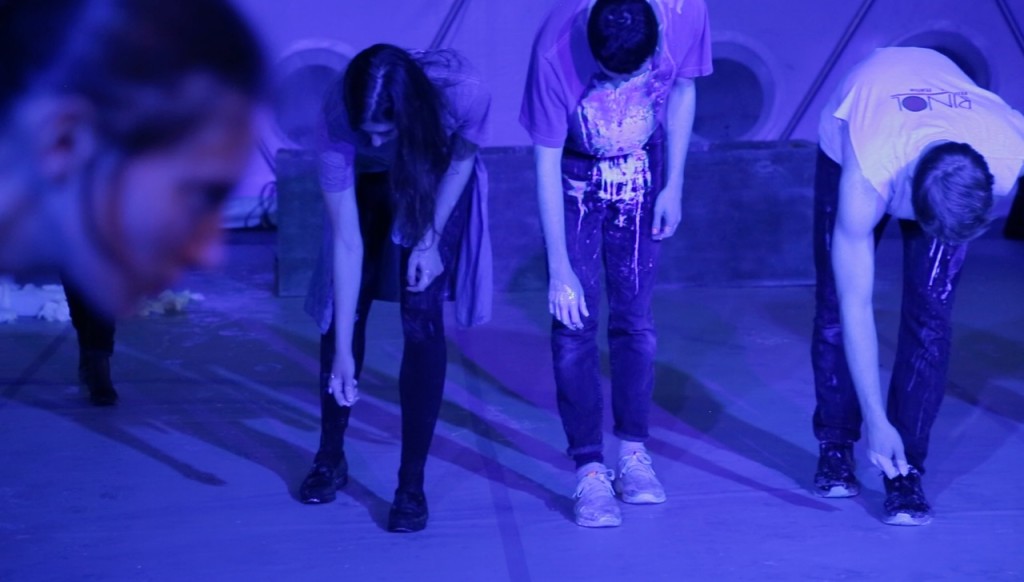
Whether we look on this substance as the material expression of friendship, sexual power or desire, or any other number of dynamics, it is clear that the buttermilk functions as a kind of currency, one for which the performers “work really hard.” In DEAL, the performers don’t always seem quite in control of their hands; they seem to move as though guided by another, or as though they are touching something invisible. The performers sometimes appear to crack their necks, another half-undead gesture. But they are the opposite of zombies — they appear to have control of their minds, but less of their bodies. Though alienation has been related to economics since Marx, perhaps its terms have changed. Rather than the worker turning up to the factory and experiencing alienation from his bodily labor, in today’s marketplace the entrepreneurial individual must always be thinking of new ways to shine, to connect, to transform, to work — (ice-cold) body be damned.
III.
This kind of behavior is rife in the contemporary art world. It is abundantly clear that our globalized network of freelancers (artists, writers, curators, dealers) runs in such a way that the large majority find themselves in situations of deep dependency. The effects of this are manifold — and can be witnessed at a micro and macro level. Vulnerable stress points arise in this system most obviously at public institutions when they take money from a compromised source. The Tate was subject to a barrage of protests after the Deepwater Horizon disaster, when groups rallied against the museum’s sponsorship by BP, the oil company responsible for the spill. Activists took their cause even further, throwing molasses (resembling oil) at attendees of the annual Tate summer party. As well as relying on patrons and corporate sponsors, museums such as MoMA and the Tate now expressly rely on their colleagues in commercial galleries to fund the production of work by the artists that they represent. Galleries, in turn, refer to their artists’ museum exhibitions as selling points.
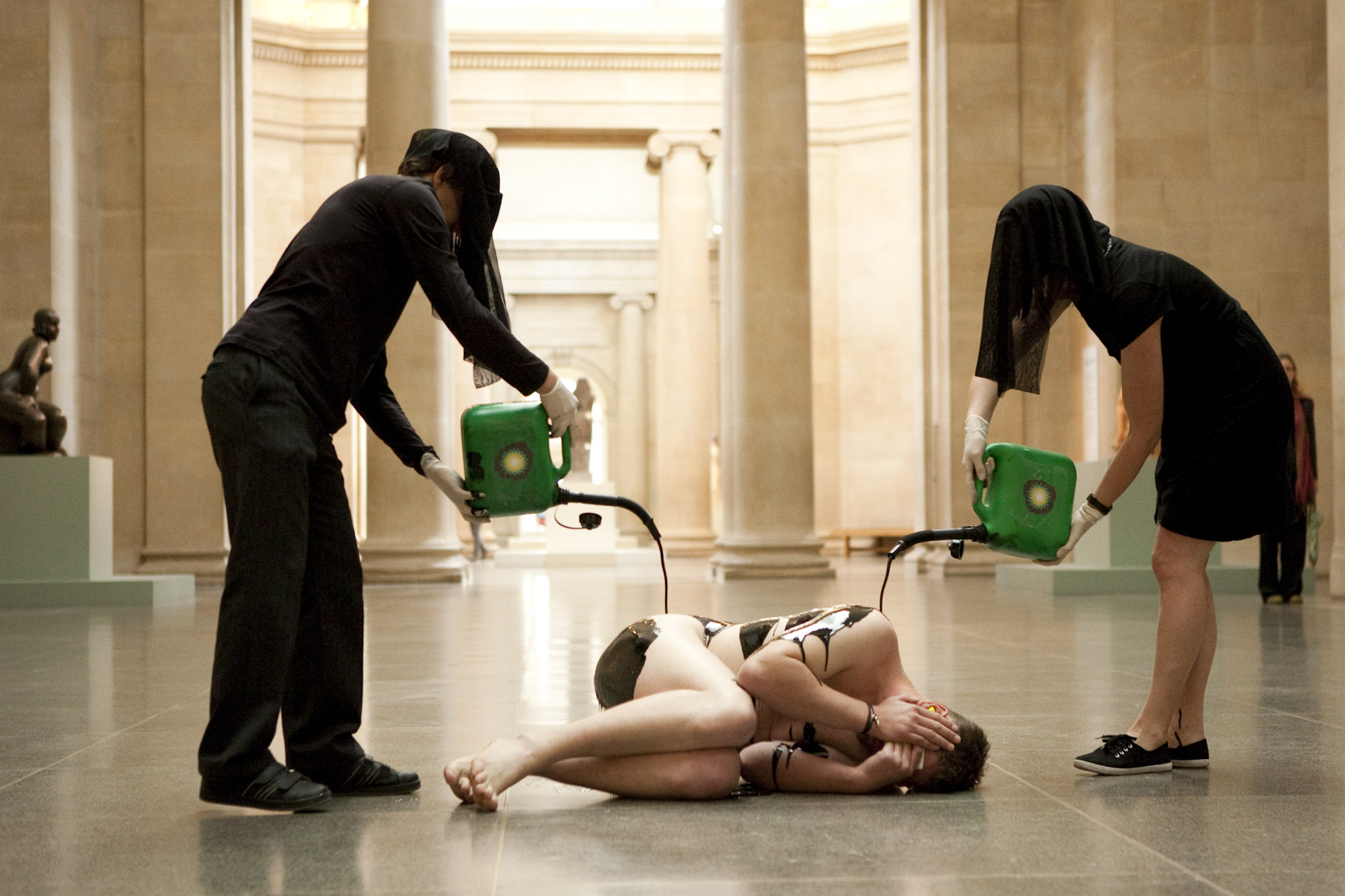
At the individual level, however, all social relationships are open to monetization or careerism. Artists, curators and writers have ended up at the same openings, dinner tables and panel discussions for decades, but the operations of their relationships and tastes have never been more visible. What happens when behavior changes to suit the network? Or art does? When every actor in a network is aware, painfully aware, that they are part of the same milieu, criticism becomes increasingly fraught. Social networking is generally hostile to critical conversation — being based on an economy of lovehearts and thumbs up. Socializing is now highly professionalized. A critic friend reviews an artist friend’s exhibition and posts it online. The artist publicly thanks the critic. It all gets a lot of likes. They like each other’s pictures of cats. You liked them too. (This is all a form of work, don’t forget.)
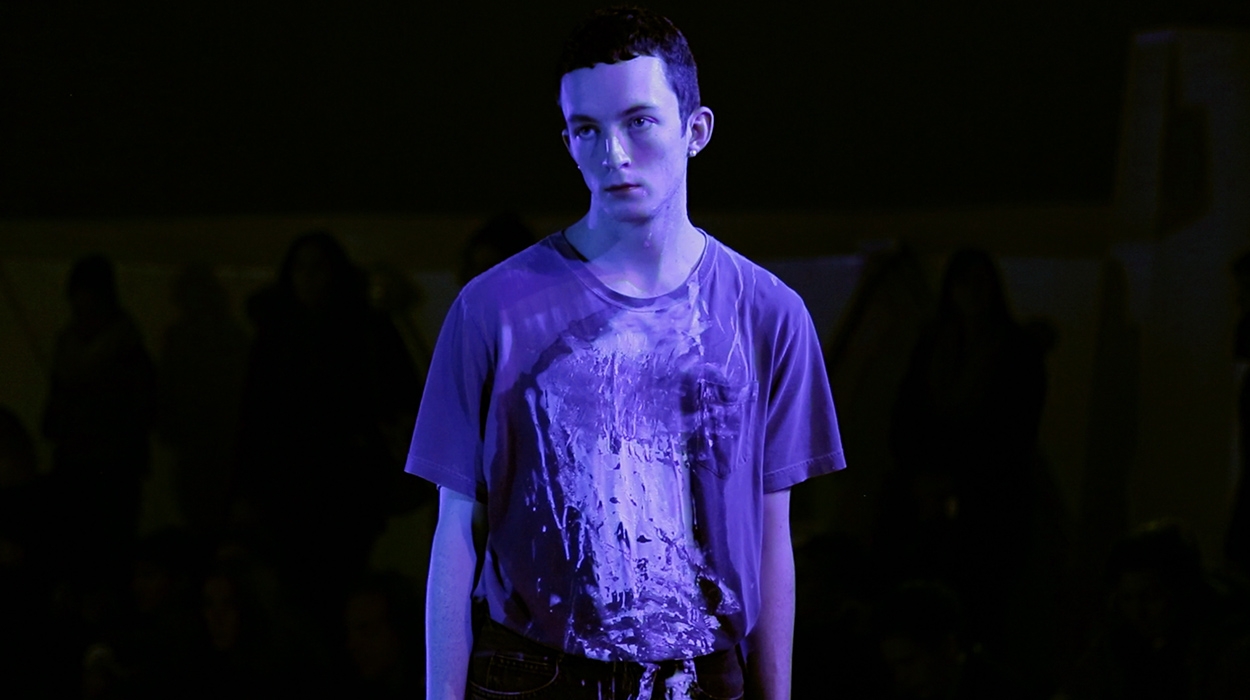
In light of this connectivity and complicity, the concentration on tangible experiences related to networked ingestion by Imhof, Douard, Baremboym, and Cheng is crucial. The tools by which power is manipulated and coercion is accomplished are becoming increasingly hard to see with one’s eyes; you might have to feel their impact using other senses. The current age sees networked humans engaged in unprecedented intimacy with corporations, objects, machines, and governments, all of which have access to so much data about our movements and interests that they barely know how to read or interpret it. Amazon, Google, and Facebook offer narrow confirmations of our own predigested interests, and yet despite our knowledge that we are being surveyed and tracked, we still cannot see or feel the algorithms that methodically scan all of our purchases, clicks, pictures and phone calls for the information that governments and corporations require. As with an illness that remains latent for years, it is difficult to track the impacts of such subtly modified controls on society until we find that we are living them. Until we are carrying out tasks that we never wanted to, addicted to things we don’t like, or dumping ice-cold water over our heads, thinking: well, we worked really hard to get here.